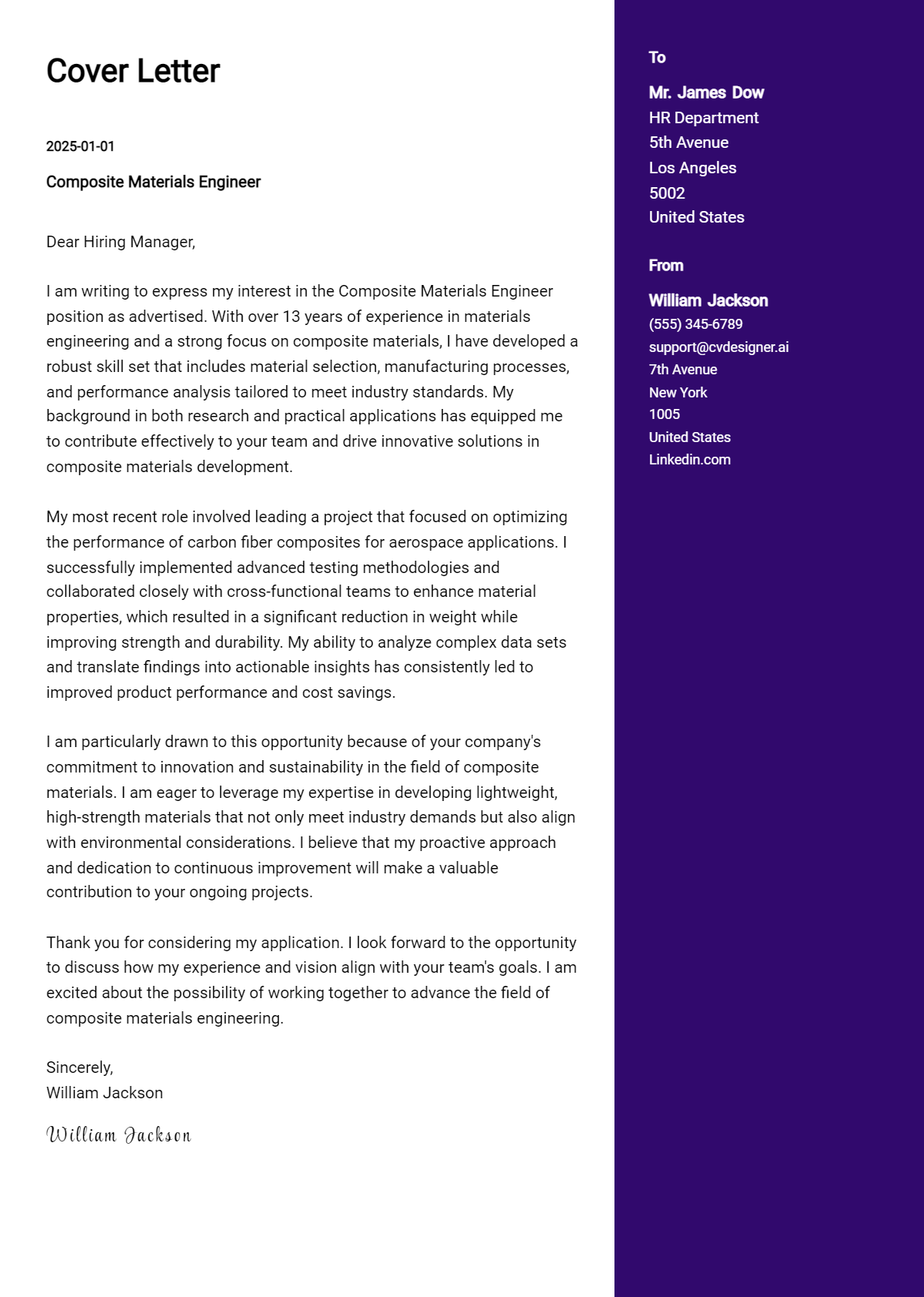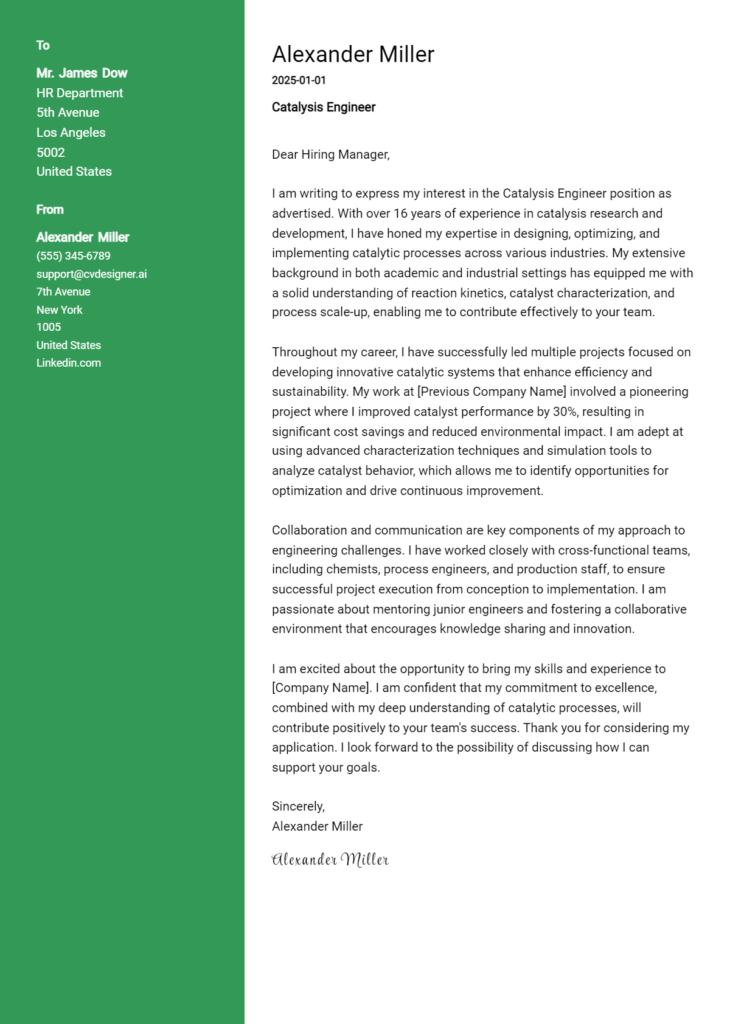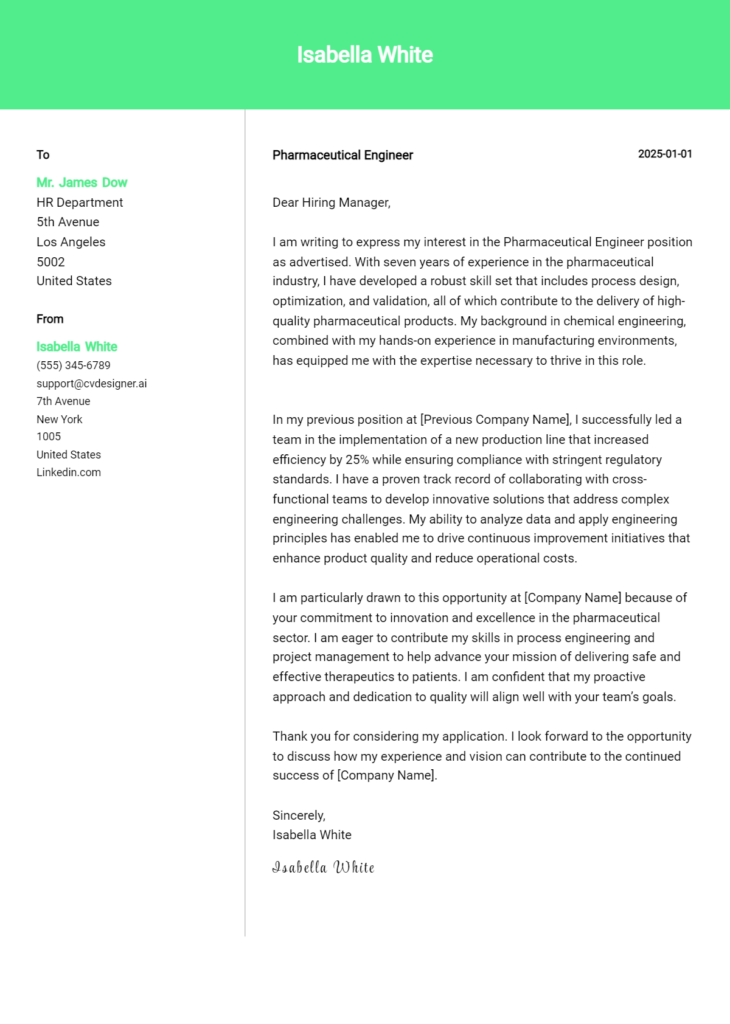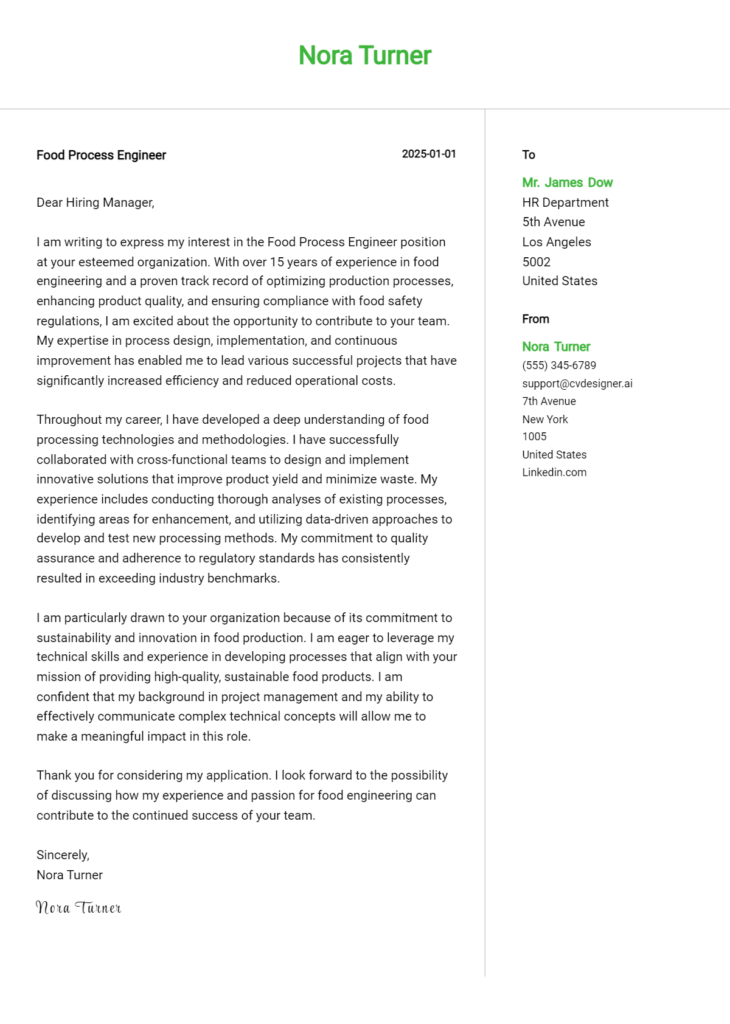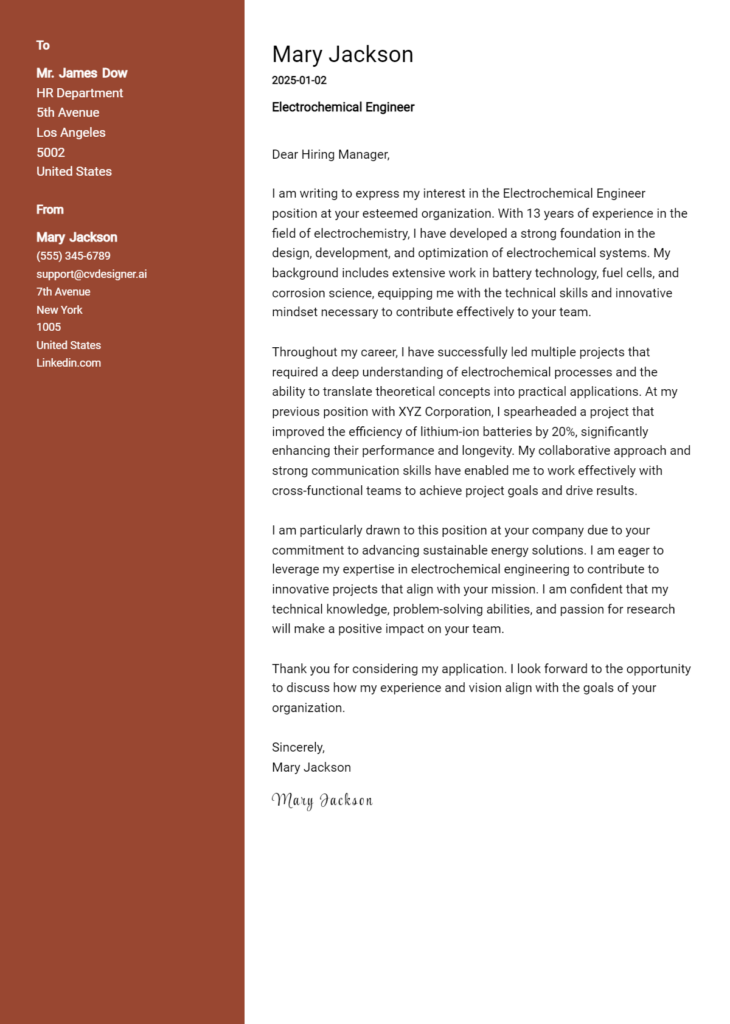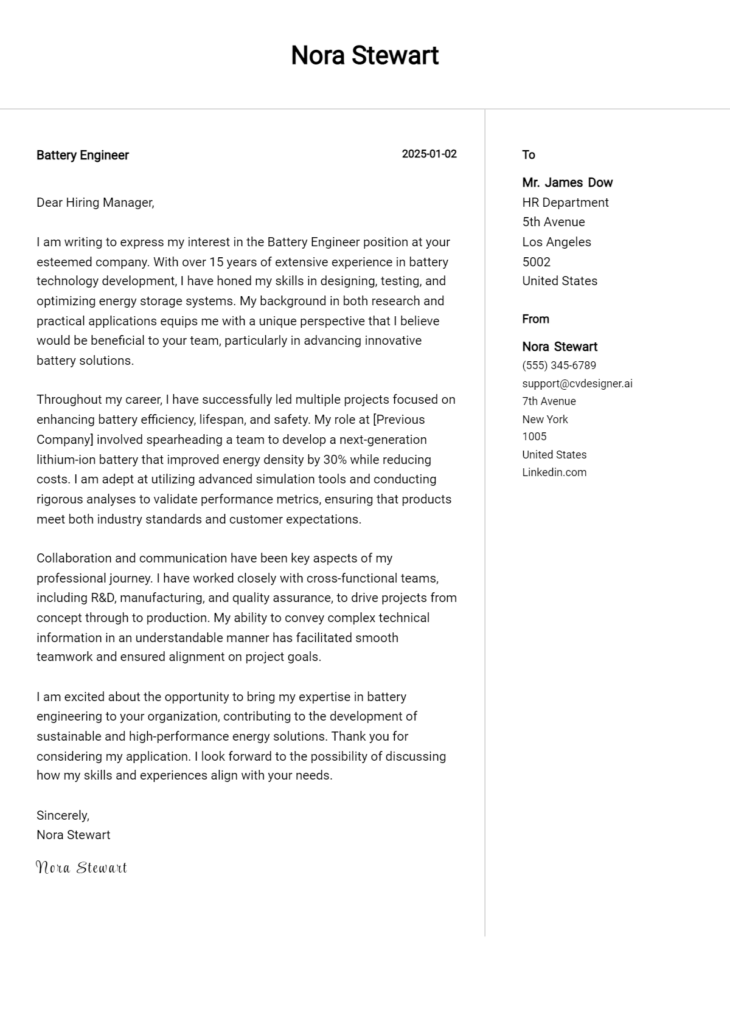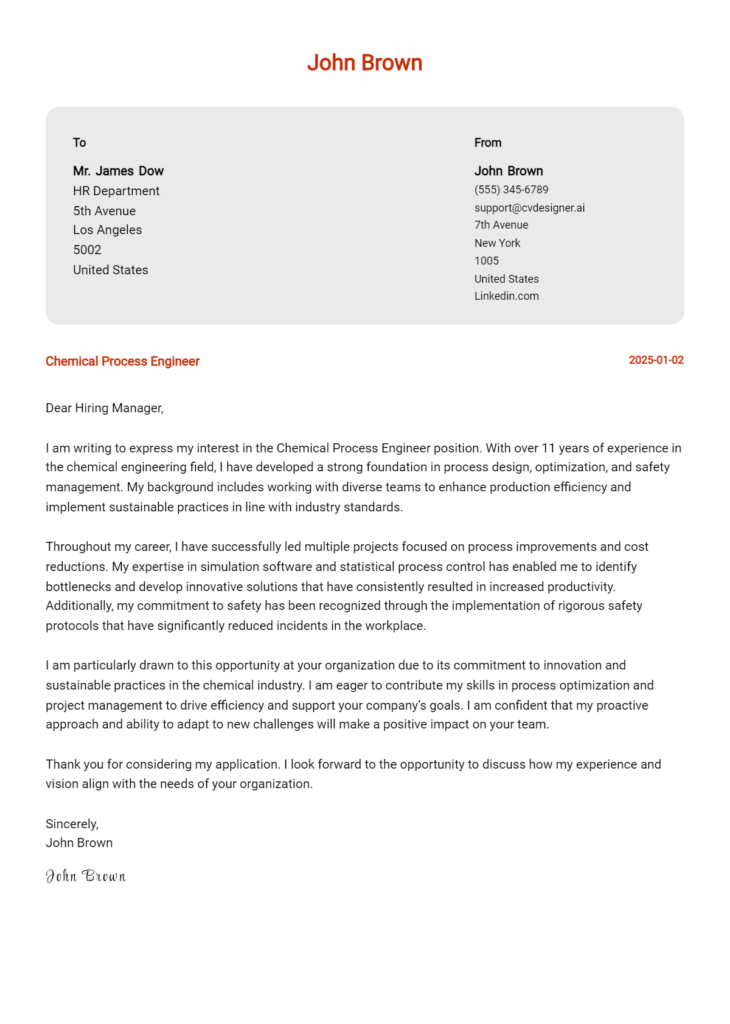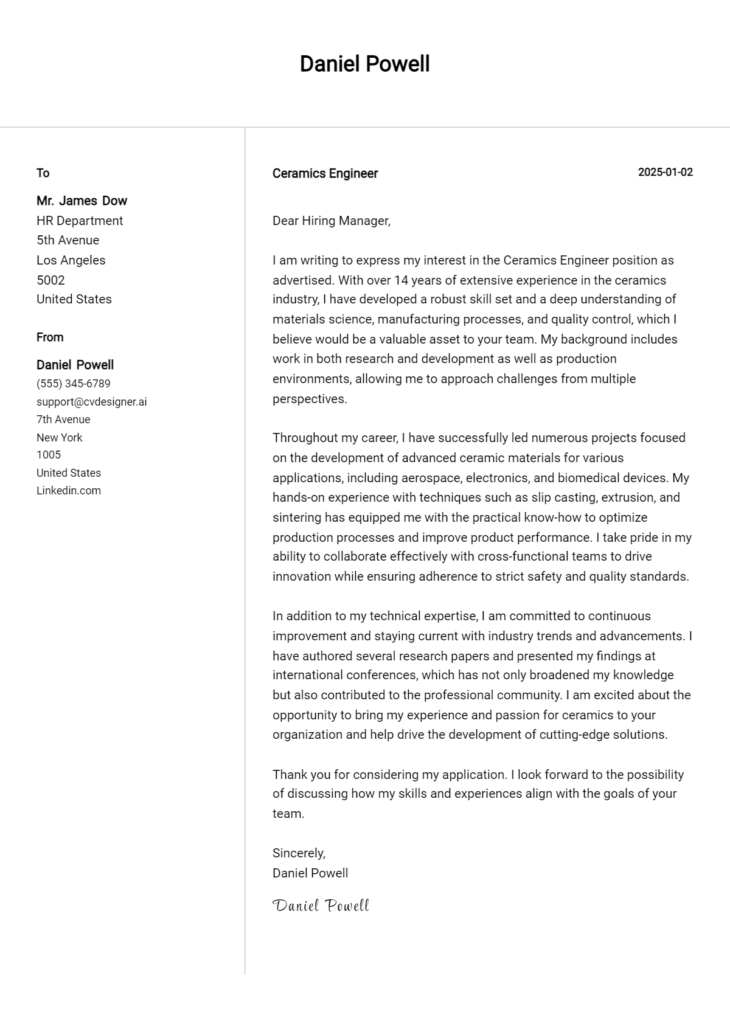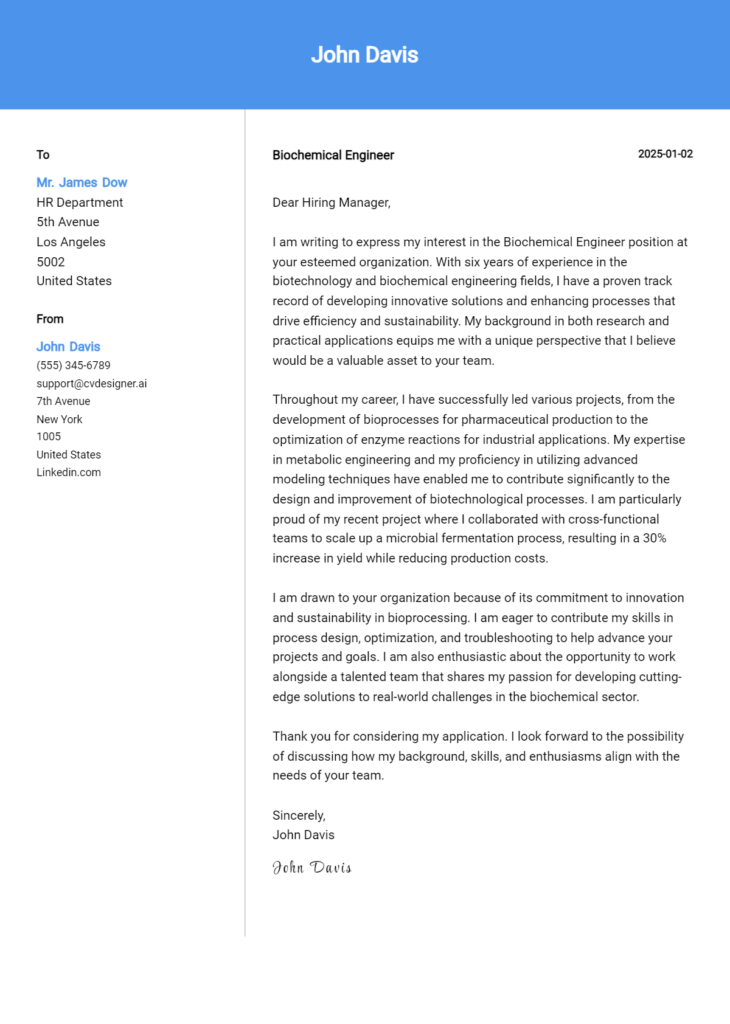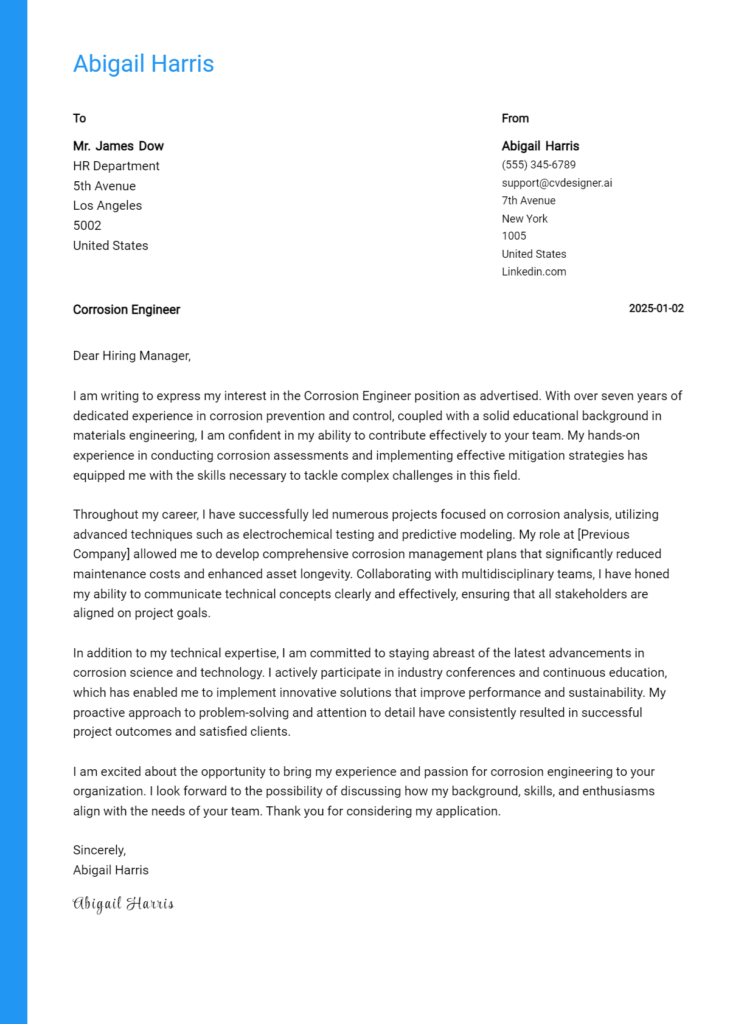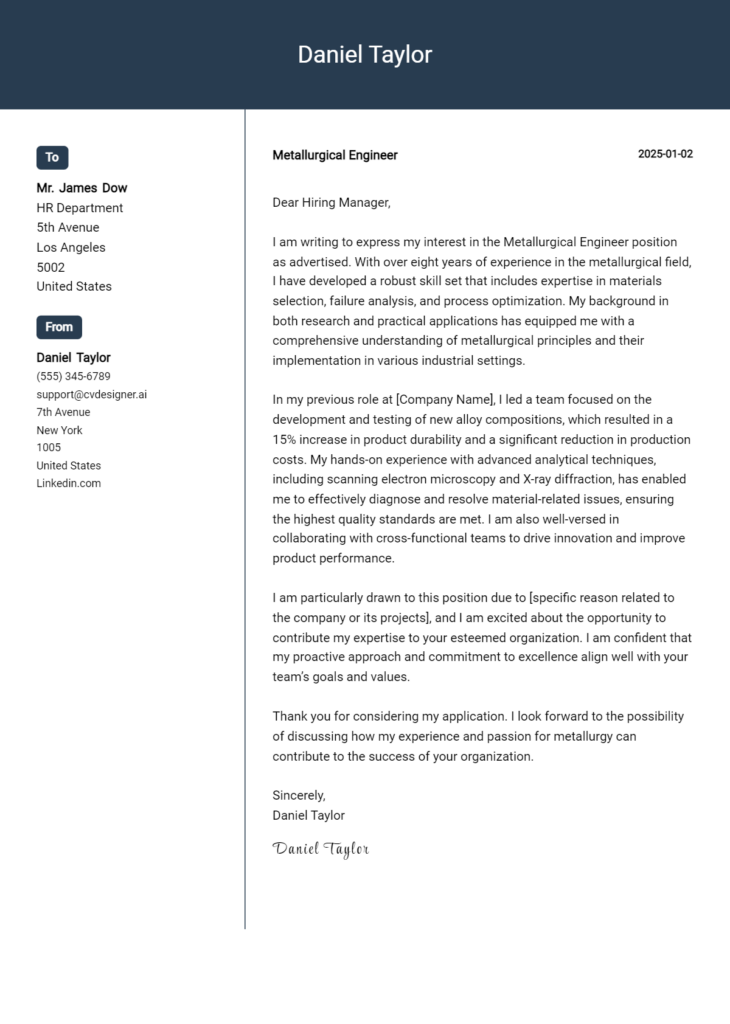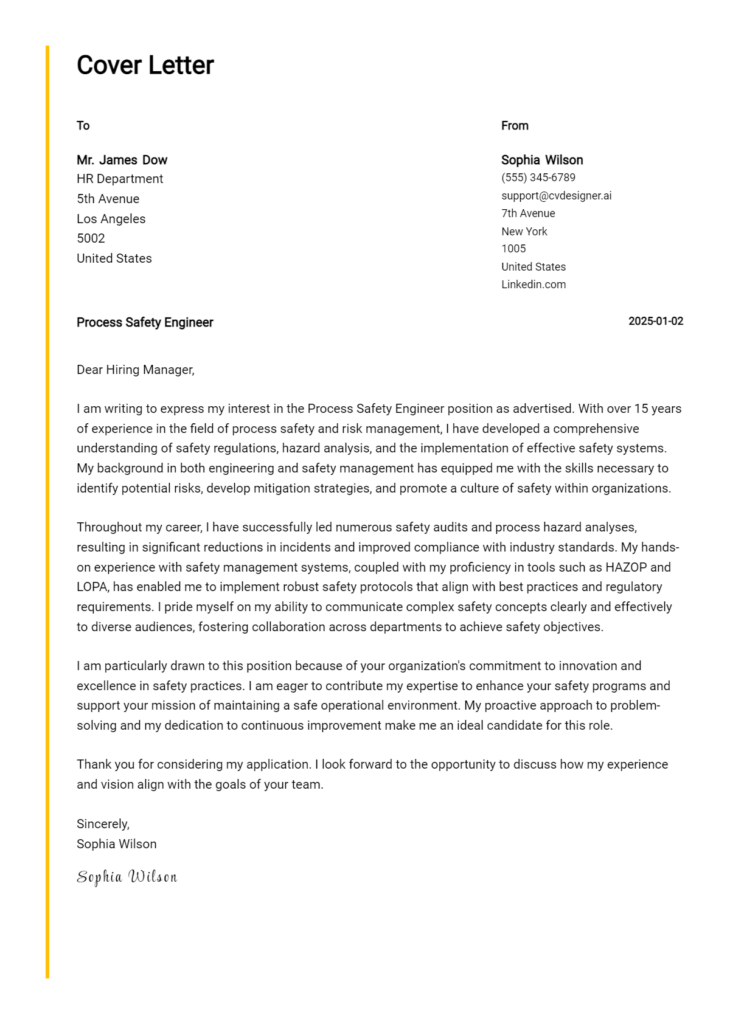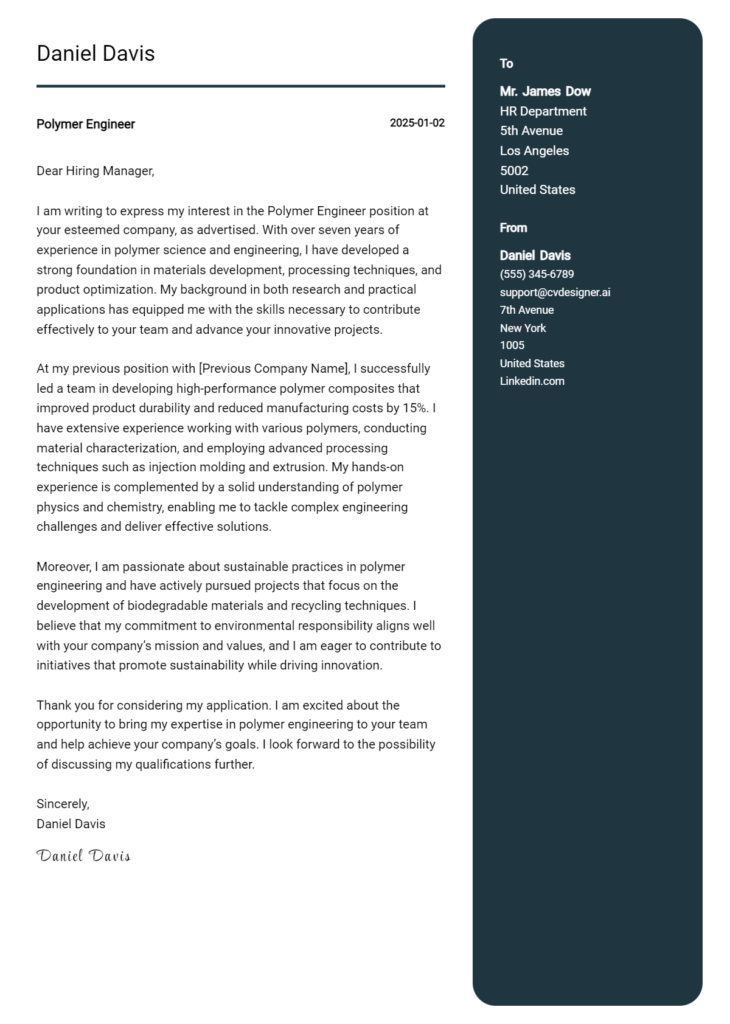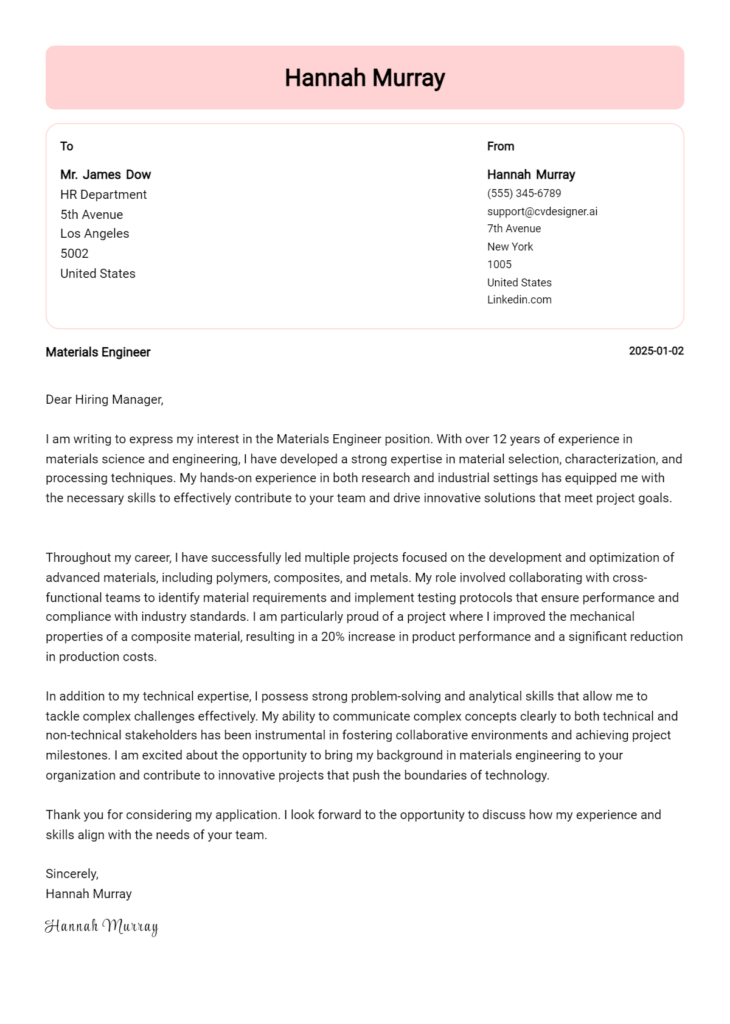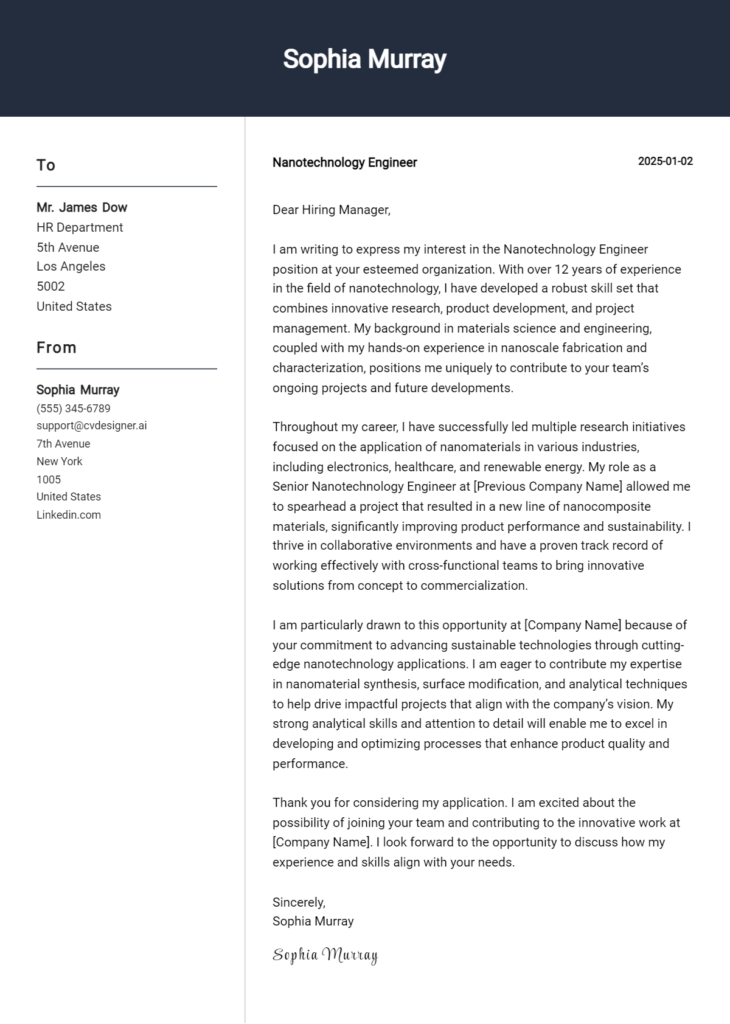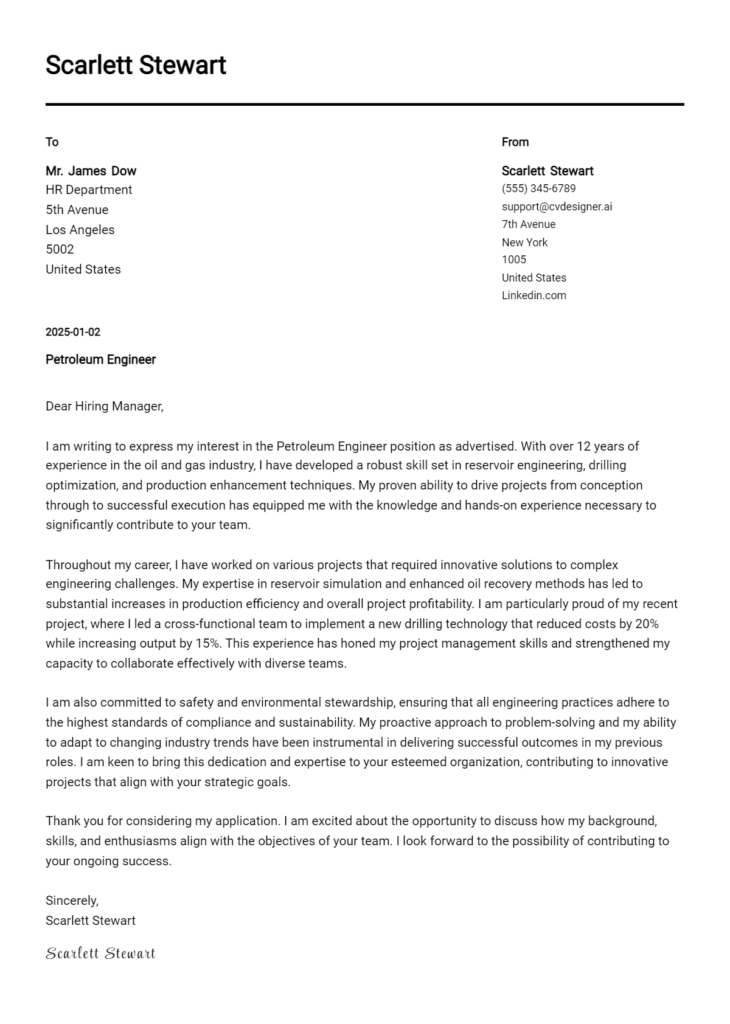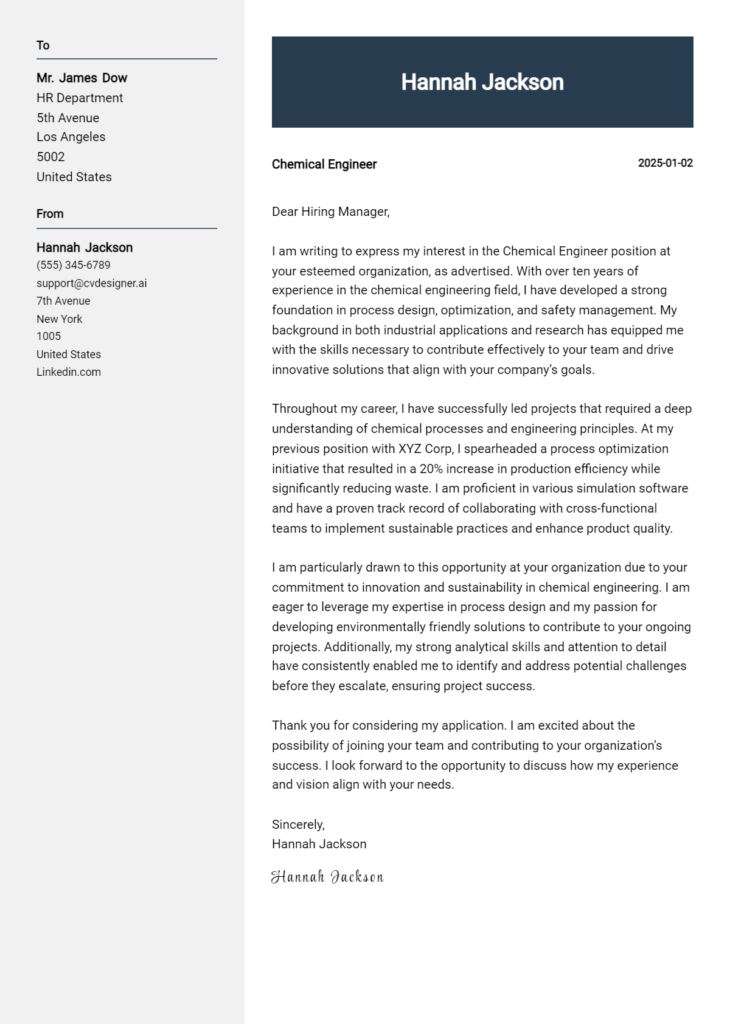Composite Materials Engineer Cover Letter Examples
Explore additional Composite Materials Engineer cover letter samples and guides and see what works for your level of experience or role.
Importance of Formatting a Composite Materials Engineer Cover Letter
Crafting a compelling cover letter for a Composite Materials Engineer is essential for making a strong first impression. The way you present your skills and experiences reflects your technical expertise and attention to detail—traits that are critical in the field of composite materials. A well-structured cover letter not only captures the hiring manager's interest but also demonstrates your ability to communicate effectively, which is vital in this highly specialized engineering discipline.
In this guide, we will outline the key components of an effective cover letter, providing insights and examples tailored for Composite Materials Engineers.
We will focus on the essential elements of a professional cover letter, including:
- Cover Letter Header
- Cover Letter Greeting
- Cover Letter Introduction
- Cover Letter Body
- Cover Letter Closing
Each section is crucial in emphasizing your qualifications and professionalism. Let’s explore how to make your cover letter stand out in the competitive field of composite materials engineering.
Importance of the Cover Letter Header for a Composite Materials Engineer
The cover letter header is a crucial component of any job application, especially for a Composite Materials Engineer where professionalism and clarity are paramount. It serves as the first impression to potential employers and sets the tone for the entire application. A well-structured header should include the applicant's contact information, the date of the application, and the recipient's details, ensuring that all relevant parties can easily identify the correspondence. A clear and professional header not only reflects attention to detail but also enhances the overall presentation of the application.
Strong Example:
John Doe 123 Composite Way Engineering City, ST 12345 (123) 456-7890 john.doe@email.com October 1, 2023 Dr. Jane Smith Hiring Manager Advanced Materials Inc. 456 Innovation Drive Technology Town, ST 67890
Weak Example:
john d. 123 composite way, city, st 12345 10/1/23 to whom it may concern,
The Importance of the Cover Letter Greeting
The greeting of a cover letter serves as the first impression you make on a potential employer and is crucial in setting the tone for the entire letter. A well-crafted greeting demonstrates professionalism and personal investment in the application process, as it shows that you have taken the time to address the hiring manager directly. This personalization can help establish a connection and convey your enthusiasm for the position. It's important to avoid generic greetings like "To Whom It May Concern," as they can come across as impersonal and disinterested. Instead, take the time to research the recipient's name, which can often be found on the company's website or LinkedIn. This small effort can significantly enhance the impact of your cover letter.
Strong Greeting Example
Dear Dr. Jane Smith,
Weak Greeting Example
To Whom It May Concern,
The Importance of a Strong Cover Letter Introduction for a Composite Materials Engineer
A well-crafted cover letter introduction is crucial for a Composite Materials Engineer as it serves as the first impression to the hiring manager. This introduction should effectively capture attention, express genuine interest in the position, and briefly highlight key skills or achievements relevant to composite materials. A strong introduction sets the tone for the rest of the cover letter, encouraging the reader to delve deeper into the candidate's qualifications. Conversely, a weak introduction may fail to engage the reader, leaving them unimpressed and disinterested. Below are examples that illustrate the difference between a strong and weak cover letter introduction.
Strong Example
Dear Hiring Manager, As a dedicated Composite Materials Engineer with over five years of progressive experience in developing advanced composite solutions for aerospace applications, I am excited to apply for the position at [Company Name]. My background in optimizing material properties and my recent success in leading a team that reduced production costs by 20% while enhancing performance metrics uniquely position me to contribute to your innovative projects. I am eager to bring my expertise in composite material design and analysis to your esteemed organization.
Weak Example
To Whom It May Concern, I am writing to apply for the Composite Materials Engineer position. I have some experience in this field and believe that I might be a good fit for the job. I hope to discuss my qualifications further.
Cover Letter Body for a Composite Materials Engineer
The body of a cover letter for a Composite Materials Engineer serves as a pivotal section where candidates can effectively showcase their technical skills, relevant experiences, and the unique value they bring to the company. This part of the letter should highlight specific projects or accomplishments that demonstrate the candidate's expertise in composite materials, such as successful development of lightweight structures, innovative manufacturing processes, or collaboration on interdisciplinary teams. By detailing these experiences, candidates can illustrate their problem-solving abilities and how they have positively impacted previous employers, making a compelling case for why they should be considered for the position.
Strong Example
I have successfully led a project to develop a new composite material that reduced the weight of aerospace components by 30%, while maintaining structural integrity. This innovative solution not only enhanced the performance of the aircraft but also contributed to significant cost savings in manufacturing. My collaboration with cross-functional teams allowed us to streamline the production process, resulting in a 15% reduction in lead time. I am excited about the opportunity to bring this expertise in composite materials design and manufacturing to your esteemed company, particularly in your upcoming projects focused on sustainable aviation technologies.
Weak Example
I have worked with composite materials for a few years. I think I would be a good fit for your company. I have done some projects in the past, but I don’t remember the details. I can work well with teams and I am enthusiastic about engineering. I hope to contribute to your projects in some way.
Importance of Cover Letter Closing for a Composite Materials Engineer
The closing paragraph of a cover letter is crucial as it provides a final opportunity to summarize your qualifications, reaffirm your enthusiasm for the position, and encourage the hiring manager to take the next steps, such as reviewing your resume or scheduling an interview. A strong closing leaves a lasting impression, emphasizing your suitability for the role and your eagerness to contribute to the company. Conversely, a weak closing can diminish the impact of your application, making it easy for the hiring manager to overlook your potential.
Strong Example
Thank you for considering my application for the Composite Materials Engineer position. With a robust background in advanced composite materials and a passion for innovative engineering solutions, I am excited about the opportunity to contribute to your team. I believe my skills in material selection and structural analysis will be valuable to your projects. I look forward to the possibility of discussing my application further and am eager to provide additional insights into how I can support your goals. Please feel free to contact me to schedule an interview at your earliest convenience.
Weak Example
Thanks for reading my letter. I hope you like my resume. It would be nice to talk again. Let me know if you want to set up a meeting.
Crafting an effective cover letter is crucial for candidates aspiring to become a Composite Materials Engineer, as it serves as a first impression to potential employers. A well-written cover letter should not only highlight your technical skills and problem-solving abilities but also showcase your knowledge of the Software Development Life Cycle (SDLC), your capability to work within a team, and your passion for continuous learning. The following tips will guide you in creating a compelling cover letter that aligns with these essential qualities.
Tips for Writing a Cover Letter as a Composite Materials Engineer
Highlight Relevant Technical Skills: Detail specific technical skills related to composite materials, such as knowledge of resin systems, fiber reinforcements, and manufacturing processes. Use concrete examples from your past experience to illustrate how these skills contributed to successful projects. Consider utilizing cover letter templates to structure your points effectively.
Emphasize Problem-Solving Abilities: Employers value engineers who can tackle challenges efficiently. Share an example of a complex problem you faced in a project involving composite materials and describe how you approached and resolved it. This not only demonstrates your technical expertise but also your analytical thinking and innovation.
Demonstrate SDLC Knowledge: If you have experience in software tools or applications used in the design and testing of composite materials, mention this in your cover letter. Discuss how your knowledge of the Software Development Life Cycle has helped you manage projects or collaborate with cross-functional teams, reinforcing your versatility as an engineer.
Showcase Teamwork and Collaboration: Engineering is often a collaborative effort, so it’s important to illustrate your ability to work effectively with others. Describe a team project where your contributions were key to achieving a common goal, emphasizing communication skills and your role in fostering a positive team dynamic.
Express a Passion for Continuous Learning: The field of composite materials is constantly evolving, making it essential to stay updated on the latest technologies and methodologies. Mention any relevant certifications, workshops, or courses you have taken to enhance your skills. This demonstrates your commitment to professional growth and adaptability in a rapidly changing environment.
By integrating these tips into your cover letter, you will effectively present yourself as a qualified candidate for a Composite Materials Engineer position. If you need further assistance in formatting your cover letter, consider using a cover letter builder to streamline the process and ensure your application stands out.
Common Mistakes to Avoid in a Composite Materials Engineer Cover Letter
Crafting a compelling cover letter is essential for standing out in the competitive field of composite materials engineering. Avoiding common mistakes can significantly enhance your chances of making a positive impression on potential employers. Here are some pitfalls to steer clear of:
Generic Language: Using a one-size-fits-all approach can make your letter forgettable. Tailor your cover letter to the specific job and company.
Lack of Specific Examples: Failing to provide concrete examples of your accomplishments can weaken your case. Highlight specific projects or experiences that showcase your skills in composite materials.
Neglecting Formatting: An improperly formatted cover letter can detract from your professionalism. Ensure you follow an appropriate cover letter format, with clear sections and a polished appearance.
Overly Technical Jargon: While it’s important to demonstrate your technical knowledge, overloading your letter with jargon can alienate non-technical readers. Balance technical details with accessible language.
Ignoring the Employer's Needs: Focusing too much on what you want rather than what the employer needs can be a major misstep. Research the company’s goals and align your skills with their requirements.
Spelling and Grammar Mistakes: Typos can undermine your credibility. Always proofread your letter or utilize tools to check for errors before submitting.
Not Including a Call to Action: A weak closing can leave employers unsure of your intentions. Clearly express your desire for an interview or further discussion, making it easy for them to respond.
By steering clear of these mistakes and exploring cover letter examples, you can craft a winning cover letter that highlights your qualifications and enthusiasm for the role.
Cover Letter FAQs for Composite Materials Engineer
What should I include in my cover letter as a Composite Materials Engineer?
In your cover letter, highlight your educational background in materials science or engineering, particularly focusing on composite materials. Include specific experiences, such as projects involving the design, testing, or manufacturing of composite materials. Mention any relevant software skills, such as CAD or simulation tools, and certifications that enhance your qualifications. Tailor your letter to the job description by demonstrating how your skills align with the company's needs. Lastly, express your passion for the field and your eagerness to contribute to innovative projects.
How can I demonstrate my technical skills in the cover letter?
To effectively showcase your technical skills, provide concrete examples of your past work with composite materials. Discuss specific projects where you applied your knowledge of material properties, manufacturing processes, or analysis techniques. For instance, you might mention optimizing a composite layup process to improve product performance or developing a new testing method for durability. Use metrics to quantify your achievements, such as reduced weight or improved strength. This not only highlights your expertise but also illustrates your ability to make a measurable impact.
Should I mention teamwork and collaboration in my cover letter?
Absolutely. Collaboration is essential in engineering roles, especially in fields like composite materials where products often integrate various disciplines. In your cover letter, describe instances where you worked successfully in a team to achieve project goals. Highlight your role in interdisciplinary teams that included designers, manufacturers, and quality assurance personnel. Emphasizing your communication skills and ability to work well with others shows that you are a well-rounded candidate who can contribute positively to the company culture and project outcomes.
How long should my cover letter be?
Your cover letter should ideally be one page long, consisting of three to four concise paragraphs. Aim for about 250 to 400 words total. This length is sufficient to introduce yourself, outline your relevant experiences and skills, and convey your enthusiasm for the position without overwhelming the reader. Keep your sentences clear and to the point, focusing on the most important aspects of your qualifications. A well-structured and succinct cover letter will make a strong impression on hiring managers and increase your chances of being invited for an interview.
Build your Cover Letter in minutes
Use an AI-powered cover letter builder and have your letter done in 5 minutes. Just select your template and our software will guide you through the process.

